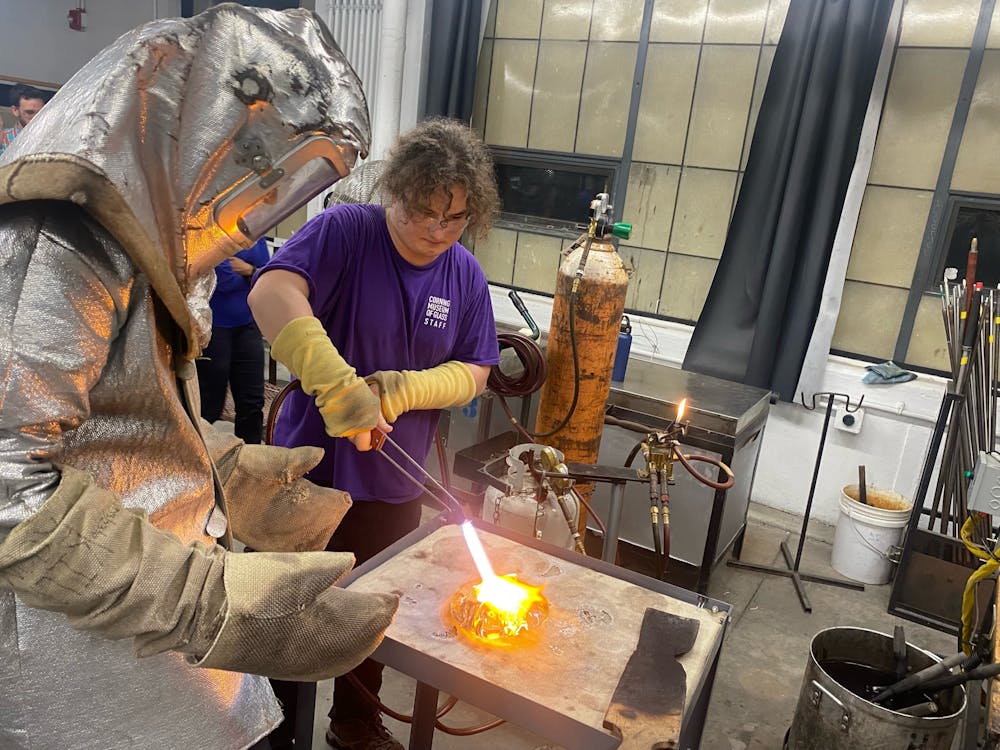Every Wednesday, students and faculty of the Brown-Rhode Island School of Design community gather to appreciate the art of glassmaking at RISD’s “Hotnights,” a program held by RISD’s glass department with a new visiting artist each week.
The purpose of the program is to promote a "greater understanding of glass and its significance to an array of disciplines,” according to its website.
Glass department head Jocelyne Prince said the idea for Hotnights began around 15 years ago in response to growing numbers of students visiting the hot shop, RISD’s facility for glassmaking arts. The shop is equipped with tools like continuous-melt glass and casting furnaces.
“We’ve had everyone from scientists to poets to other visual artists and conceptual writers come in,” said glass professor Sean Salstrom. “The biggest thing is that people are curious.”
“Glass always reveals a new way to work,” Prince said, “I think it is a really underexplored material.”
Salstrom participated in athletics as a child, and glassmaking was the first art form he found that reflected the things he liked about athletics — “like teamwork, total physicality, choreography, timing,” he said.
“It’s a very ambiguous material that has all kinds of comprehensive approaches,” Salstrom said. “Glass can mimic any other material through texture and surface treatment,” including rock, water and ice, he said, “I don’t think people understand the breadth of which glass could be used visually, let alone conceptually.”
Brown-RISD dual degree student and glass concentrator Adam Meller ’25 was intrigued by how “working with the material involves a balance of craft and design” and often results in “processes that are repeatable but also unique.”
In high school, Meller explored the relationship between images and optics, transferring photos onto acrylic boards and projecting light through plastic. “Studying glass felt like a way for me to take more material agency over my work,” he said.
Hotnights embraces the growing range of techniques in glassmaking, which “just get more exciting” as glass makers discover “nontraditional” modes of working with the material, Prince said. The program also allows the department to think about problem-solving together, which is especially important given the safety precautions required of students working with molten glass, she said.
This week, new media artist Triton Mobley collaborated with the department. New media is a visual arts genre rooted in creating art through electronic media technologies. Mobley’s interventionist works and guerilla performances have been exhibited across the world, according to his website.
“The Hotnights programming is designed as a multidisciplinary event for both participants and observers,” which creates the potential for a “shared exchange in ideas,” Mobley wrote in an email to The Herald.
The glass department pedagogy builds on unique histories of traditional glass making “imbued with limitless potential incorporating sculpture, architecture, design, craft and decorative art,” according to the department website.
Salstrom emphasized that Hotnights is less about producing work than considering questions “we don’t have an answer to.” Many visiting artists have little to no experience with glass, which makes Hotnights their introduction to the medium. The department is “willing to think differently” and experiment according to the artists’ ideas, Prince said.
It was Mobley’s first “official opportunity” to work with the department, he wrote. His project “attempts to embed a kind of archival media and its associated cultural ‘DNA’ into amber (colored glass),” he added.
Through the medium of glass Mobley has the chance to “exacerbate or counter the technical limitations within display technologies,” he wrote.
Hotnights tries to generate enthusiasm about glass and help people realize the potential for a lifelong engagement with the material, Salstrom said. “Everywhere around the world, people who work in glass have a certain kind of language,” he said. You can wander into any glass studio in the world, and they’ll “take you in,” he added.
Hotnights is held weekly from 7 to 10 p.m. on the fourth floor of the Metcalf Building at RISD.





